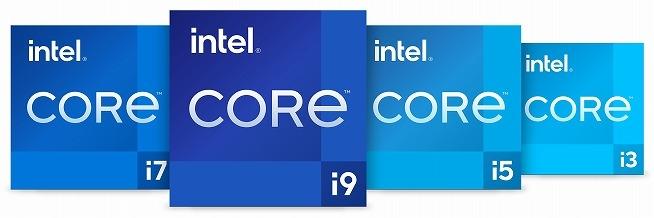Intel announced a large number of 12th generation Core series codenamed "Alder Lake" at the consumer electronics trade fair "CES 2022". The main announcements this time are for mobile devices targeting laptop computers and integrated PCs, but new ones for desktop computers are also available.
Index
The 12th generation Core series was announced last year for desktops, and one of the major features is that it contains two types of cores with different performances. This is the first time that this structure has been adopted except for "Lakefield", which has low performance and not many products are installed.
ThinkPad X1 Fold, one of the rare Lakefield-equipped PCs. Only this and the Galaxy Book S can be found on Lakefield-equipped PCs.
With the same efforts as "big.LITTLE" of SoC adopting Arm architecture such as Snapdragon, M1 and A15, high power consumption high performance P core (Performance Cores) and low power operation, power efficient E It consists of cores (Efficient-cores). Also, since all E-cores do not support multithreading, the number of threads does not double or double the number of cores.
However, "Intel Thread Director" that allocates tasks appropriately is currently only compatible with Windows 11, and if you use it other than Windows 11, there is a concern that high-load tasks will not be allocated properly and performance will deteriorate, but for Linux It is said that it will be supported in the future.
This 12th generation Core H series is positioned as the successor to the "Tiger Lake-H45" for gaming notebooks of the 11th generation Core family. Eight products are available for the H series, including the Core i9 12900H and the 12900HK with adjustable overclocking magnification.

The top Core i9-12900HK has 14 cores and 20 threads, and is equipped with 6 P cores and 8 E cores. The P core can be boosted up to 5GHz and the E core can be boosted up to 3.8GHz, while the E core has a considerably suppressed base clock of 1.8GHz. This can reduce power consumption under low load and improve battery life. Intel claims that the game performance has improved by 28% when comparing the Core i9-12900HK with the Core i9-11900HK.
Commonly, the built-in GPU is Iris Xe graphics, but the number of graphics cores is from 48 cores to 96 cores. In the 11th generation Core H-45 series, the number of GPU cores is only 32 cores. PCs equipped with the H series are usually equipped with GPUs such as Geforce and Radeon, so this is not a problem, but it seems that it will be easy to prepare low-priced models without GPUs. The performance of the Iris Xe graphics itself has not been elaborated, but the Core i7-1165G7, which also has 96 EU cores, was powerful enough to play some 3D games on its own.
It has been announced that the 12th generation Core H series will go on sale in February 2022 and has already been adopted in the tablet-type gaming PC "ROG Flow Z13".
The new P-series is the best choice for users who don't need the peak performance of gaming. It is a standing position that can be said to be the successor to the former "UP3".
As for the performance, the specifications are like lowering the clock frequency of the H series, and the top Core i7-1280P has 14 cores and 20 threads, but the base clock is 1.8GHz and 1.3GHz, respectively, and the base power is suppressed to 28W.
In addition, the P series has 8 cores for E cores in all 6 products. It seems that some people misunderstand that "10 cores even with i3 !? The times have changed ...". The GPU is also Iris Xe, but the number of EU cores is 96 for Core i7, 80 for i5, 64 for i3, which is more than the H series and the clock is not so different. It is a series that I am looking forward to seeing what kind of PC it will be installed in.
The U series is divided into two types, called "U15" with a base power of 15W and "U9" with a base power of 9W. If you think of it as before, the former is used for lightweight laptops and laptops that sing high cost performances, and the latter is used for slightly special devices such as UMPCs that have to be very careful about heat problems and batteries.
Both U15 and U9 are deployed with 7 models each, and the first 3 digits are common like "i7-1265U" and "i7-1260U". The top Core i7-1265U has 12 threads of 2 + 8, with specifications close to the cheapest i3-1220P in the P series, and it is a performance that can be called "Nanchatte i7".
It seems that the U series will be installed in removable, foldable, 2 in 1 etc., including the thin notebook PC announced in 2022 together with the P series. At the time of CES, it is known that the 17-inch foldable Windows tablet "Zenbook 17 Fold OLED" is equipped with Core i7-1250U.
In addition, 22 models that do not support overclocking have been added to the lineup of the "Alder Lake-S" generation for desktops, which was sold in advance only for high-end gaming. There are unbranded models with a base power of 65W, models with F that do not come with a GPU, and models with T that are limited to 35W. The desktop version has a shape that is a little closer to a square than the one for mobile.
As a big feature, Core i5 and below do not have an E core and only one type of core as before. As a result, for example, the Core i5-12600 / K / KF has 6 cores only for the unbranded version, and the 12600K / KF has 10 cores.
I won't go into detail, but the top model of the products added this time, the i9-12900, has a maximum of 5.1GHz, 16 cores and 24 threads, and is priced at $ 489 (56,000 yen). In Japan, the 12900K was in the 70,000 yen range, and the suggested retail price in North America was 589 dollars, so the price is considerably suppressed.
In addition, along with the introduction of new CPUs, H670 / B660 / H610, which is a lower chipset with reduced costs by not supporting overclocking and reducing extended functions, will be introduced. With this, it seems that the 12th generation Core series, which was limited to gaming, will finally be installed in general and business desktop PCs.
In addition, some CPUs come with a new fan. Of the 65W CPUs, the Core i9 comes with a Laminar RH1 cooler, and the Core i3 to i7 come with a Laminar RM1 cooler. Personally, I like it fashionably.


